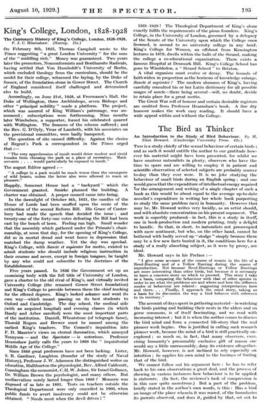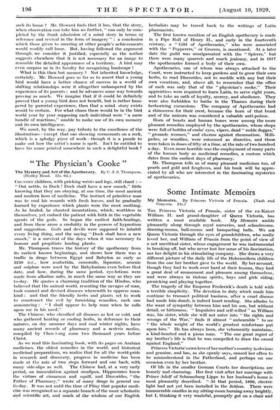The Bird as Thinker
Tuts is a study chiefly of the sexual behaviour of certain birds ; and as such it would entitle the author to our gratitude how- ever his material might have been presented, for whilst we have amateur naturalists in plenty, observers who have the time to spare and are willing to employ it in patient and scientific observation of selected subjects are probably scarcer to-day than they ever were. It is no joke studying the behaviour of small birds during an English spring ; and one would guess that the expenditure of intellectual energy required for the arrangement and writing of a single chapter of such a book as this would be about equal to the average up-to-date novelist's expenditure in writing her whole book purporting to study the same problem (sex) in humanity. However that may be, Mr. Howard writes very lucidly, as an artist should, and with absolute concentration on his present argument. The work is superbly produced—in fact, this is a study in itself', one in book-production and modern printing, truly a delight to handle. So that, in short, to naturalists not preoccupied with mere sentiment, but who, on the other hand, cannot be bothered with badly served up " stodge " simply because there may be a few new facts buried in it, the conditions here for a study of a really absorbing subject, as it were by proxy, arc ideal.
Mr. Howard says in his Preface :— " I give some account of the course of events in the life of a Reed-Bunting and of a Yellow Bunting during the season of reproduction. Not because Reed-Buntings or Yellow Buntings are more interesting than other birds, but because it is necessary to have a concrete story on which to proceed. This story I take as a basis, comparing the behaviour with that of other species in order to see what the problems are and where and how the different modes of behaviour are related : suggesting interpretation here and there. . . . Finally, I approach the mind story, taking as a basis for its discussion the way a bird behaves with reference to its territory."
The account of days spent in gathering material—in watching the birds pairing and building their nests in the alders and on gorse commons, is of itself fascinating, and we read with increasing interest ; but it is when the author comes to discuss the bird mind and form a ,connected life-story that the real pioneer work begins. One is justified in calling such research pioneer work, because the mind of a bird is still practically un- explored; so much so, in fact, that many observers, exer- cising humanity's presumably exclusive gift of reason one would say a little unreasonably, deny its existence altogether. Mr. Howard, however, is not inclined to rely especially on intuition ; he applies his own mind to the business of finding that of the bird.
We cannot follow out his argument here : he has to refer back to his own observations a great deal, and the process of showing in various instances how behaviour is to be applied is elaborate. (In fact, the reviewer's task of compression is in this case quite monstrous.) But a part of the problem, briefly stated in the author's own words, is this : Has a bird an image of the place wherein it was reared, of the boundaries its parents observed, and does it, guided by that, set out to seek its home ? Mr. Howard finds that it has, that the story, when observation can take him no further, "can only be com- pleted by the frank admission of a mind story in terms of reference and revival in the form of imagery " : a conclusion which those given to sneering at other people's achievements would readily call lame. But, having followed the argument through. we consider it justified, especially as the author suggests elsewhere that it is not necessary for an image to resemble the detailed appearance of a territory. A bird may even surpass us in its faculty for recognizing landscape !
What is this then but memory ? Not inherited knowledge, certainly. Mr. Howard goes so far as to assert that a young bird would have a better chance of success in a world of shifting relationships were it altogether unhampered by the experience of its parents ; and he advances some way towards proving as much. We imagine that if it could be definitely proved that a young bird does not benefit, but is rather ham- pered by parental experience, then that a mind story exists would be certain. For what chaos there would be in the bird world year by year supposing each individual were "a mere bundle of reactions," unable to make use of its own memory and its own intelligence.
We must, by the way, pay tribute to the excellence of the illustrations—except that one showing cormorants on a rock, which is a splodgy piece of work—though it is a puzzle to make out how the artist's name is spelt. Isn't he entitled to have his name printed somewhere in such a delightful book ?

































 Previous page
Previous page